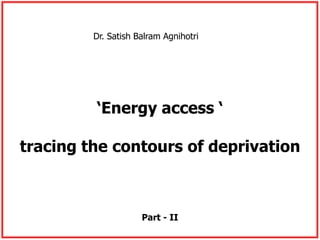
Energy access part 2 source of light
- 1. Dr. Satish Balram Agnihotri ‘Energy access ‘ tracing the contours of deprivation Part - II
- 2. Source of lighting Where do Indian citizen get the light in their lives?
- 3. Electricity as source of light
- 4. When we talk of lighting, electricity strikes us as the first source. But its distribution may not be even. Even when an area is electrified all households may not be able to have access to it. Census 2001 shows three clusters of districts – one where more than 2/3rds of households use electricity as source of lighting, one where half of the households do not get it and the third or the intermediate cluster.
- 5. < 50% 50% - 67% > 67% Source of Light Use of ‘Electricity’ in (Rural+Urban) Sector Census 2001
- 6. But the picture in the urban region is different. The cluster cut off is at 87% and 81%. Why do the poor migrate to urban areas? An answer perhaps lies there.
- 7. < 81% 81% - 87% > 87% Source of Light Use of ‘Electricity’ in Urban Sector Census 2001
- 8. The pattern of the rural deprivation is revealed from the maps below. While more than 67% households continue to use electricity for lighting in the better off zone, less than 25% households are able to do so in the large cluster in the north and east.
- 9. < 25% 25% - 67% > 67% Source of Light Use of ‘Electricity’ in Rural Sector Census 2001
- 10. Kerosene as source of light
- 11. In 2001, Kerosene seemed to be the only other source with other sources being only bit players. This can be seen from the nearly identical maps of districts where <33% households used Kerosene for lighting and the cluster where more than 67% did so.
- 12. < 33% 33% - 67% > 67% Source of Light Use of ‘Kerosene’ in (Rural+Urban) Sector Census 2001
- 13. Solar Light as source of light
- 14. Interestingly, even in 2001 there were clusters of districts where more that 0.2% households were using Solar Lights in rural and urban areas.
- 15. Source of Lighting Use of Solar Light as on Census 2001 More than 0.2% households More than 0.2% households Rural Urban
- 16. Households with ‘No source of Light’
- 17. Source of Lighting Use of ‘No Source of Lighting’ in Rural Sector Intriguingly there have been >0.5% households in certain clusters where there has been No Source of Light. These needed attention from the system More than 0.5% households Census 2001
- 18. What change do the 2011 data show ?
- 19. Map reveals >80% of households using electricity for lighting in 2011 in the same region where 2001 census showed > 67% households doing so. However and intriguingly the position in respect of the region where <50% households use electricity has remained more or less the same with the cut off reducing from 50% to 47%.
- 20. < 47% 47% - 80% > 80% Source of Light Use of ‘Electricity’ in (Rural+Urban) Sector Census 2011
- 21. Te improvement in access to electricity for lighting is seen from the map below with a clear cluster showing 80% or more households using electricity for lighting. The urban cluster where less than 80% households use electricity is used as source of lighting is more or less the same as the deprived cluster in 2001. It shows that the level of deprivation may reduce but the relative deprivation remains same.
- 22. Source of Light Use of ‘Electricity’ in Urban Sector More than 80% Households Census 2011
- 23. But the picture is not satisfactory in the rural area where the districts with more than 75% households using electricity for lighting comes down considerably.
- 24. Source of Light Use of ‘Electricity’ in Rural Sector More than 75% Households Census 2011
- 25. Not surprisingly, the cluster where more that 50% rural households use Kerosene for lighting has remained nearly unchanged.
- 26. Source of Light Use of ‘Kerosene’ in Rural Sector More than 50% Households Census 2011
- 27. What has happened to the use of solar energy? We now have a much larger patch where >0.3% households use it in rural areas while in urban such a coverage is obtained only when we lower the cut off to >0.1% of the households !
- 28. Source of Lighting Use of Solar Light as on Census 2011 More than 0.3% households More than 0.1% households Rural Urban
- 29. But interestingly there are small pockets emerging where more than 2% rural households are using solar lights.
- 30. Source of Light Use of ‘Solar Light’ in Rural Sector More than 2% Households Census 2011
- 31. A list of these districts shown in the map below is given in Annexure I
- 32. Annexure - I District Value District Value District Value District Value ANJAW 25.0 CHAMOLI 5.7 BANDIPORE 4.2 SONBHADRA 2.5 LEH (LADAKH) 18.0 KURUNG KUMEY 5.6 PASHCHIMI SINGHBHUM 4.2 EAST SIANG 2.5 DIBANG VALLEY 16.4 KARBI ANGLONG 5.5 JASHPUR 4.1 SARAIKELA-KHARSAWAN 2.4 LOWER DIBANG VALLEY 14.2 UPPER SUBANSIRI 5.4 SAIHA 3.8 SOUTH GARO HILLS 2.4 KARGIL 11.7 NORTH CACHAR HILLS 5.3 ARWAL 3.7 DHEMAJI 2.3 TAMENGLONG 11.4 CHAMPAWAT 5.2 NARMADA 3.6 DINDORI 2.2 LAHUL And SPITI 11.2 DHALAI 4.8 UKHRUL 3.0 ALIRAJPUR 2.2 KISHTWAR 10.9 KORIYA 4.7 KUPWARA 3.0 SENAPATI 2.1 CHURACHANDPUR 8.7 BARMER 4.5 PITHORAGARH 2.9 BETUL 2.1 WEST SIANG 8.7 JAISALMER 4.4 ALMORA 2.8 MAMIT 2.1 UPPER SIANG 8.2 BIJAPUR 4.4 UTTARKASHI 2.8 DANTEWADA 2.1 LAWNGTLAI 7.5 KHUNTI 4.4 BIKANER 2.7 NANDURBAR 6.8 KORBA 4.3 LUNGLEI 2.7 EAST KAMENG 6.8 SOUTH 24 PARGANAS 4.2 TEHRI GARHWAL 2.6